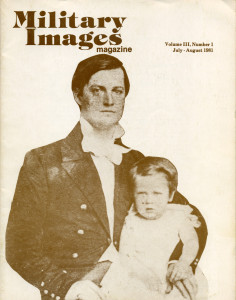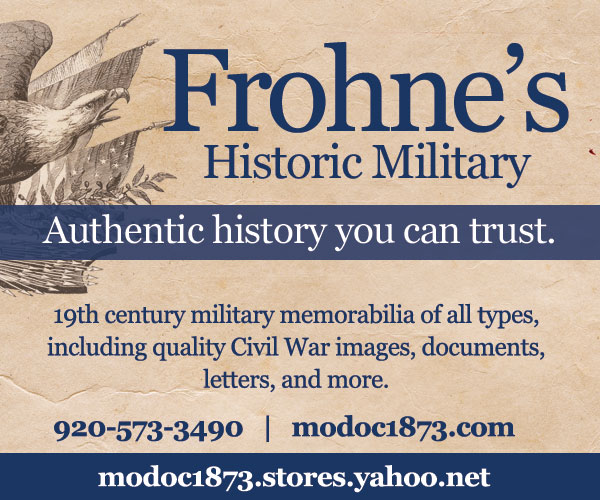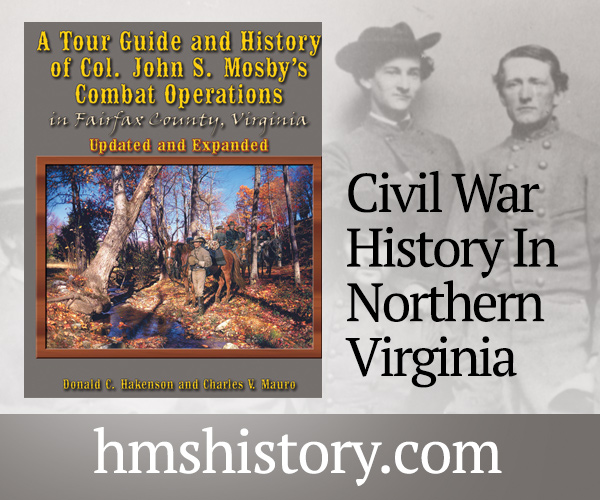The complete issue
Vol. 3, No. 1
(32 pages)
Print edition: Visit our store to check availability
Digital edition: Visit JSTOR.org to purchase
Subscribe to MI
Explore the MI Archives: Browse | Advanced search | Tutorial
Inside
Cover Image
A touching portrait of 1st Lieutenant Winfield Scott Hancock with his three year old son Russell, taken in 1853.
Editor’s Page (inside front cover)
The editor explains the effect of “hard” images, such as daguerreotypes, tintypes, or ambrotypes, and how these led to what today appears to be “backwards” images and why issues of Military Images does not change these from their original appearance.
Mail Call (pp. 2-3)
The readers’ letters include several clarifications to images from previous issues. Of interest is a comparison of the obverse and reverse of two cartes de visite of Sergeant Amos Humiston, father of the “Children of the Battlefield” images from the Civil War. One is a retouched version that was used for fundraising purposes, with the addition of a beard and Army jacket.
“Galloping Jim” Parker: Cavalryman Extraordinaire, 1872-1918 by Gordon Harrower, Jr. (pp. 4-9)
Including ten images spanning the career of “Galloping Jim” Parker and excerpts from an unpublished monography by his son, the reader is treated to an overview of the life of a veteran of the Indian Wars, the Philippine Insurrection, and the Spanish-American War. Parker was also an instructor of cavalry tactics at West Point and eventually commanding the 11th Cavalry. Some of the images are postcard photographs which provide glimpses into the inspection of his cavalry units, from three day recruits to a review at the Texas maneuver camp in 1911 which features a Wright flyer overhead. Not selected to be the commander of the A.E.F. that went into France to fight in World War One, Parker organized can commanded the unit that today is known as the “Big Red One.”
U.S. Army Uniforms of the Civil War, Part II: The Sack Coat by Michael J. McAfee (pp. 10-15)
Essentially the uniform coat worn by the common soldier, the sack coat was a cheaper, mass-produced garment that was to be worn in fatigue situations. Shorter than the frock coat and without a waist seam, this four-button coat was the standard for Union soldiers. The 15 different images provided in this pictorial article show how the uniform was worn, from one “perfect fit” example to many personal alterations done by the soldiers themselves.
William Lytle and the “Boody Tinth” Ohio by James F. Neel (pp. 16-18)
This article was inspired by a junk yard find of a photograph of ten Union soldiers with the inscription on the reverse describing it as the burial party of Brigadier General William H. Lytle, the commander of the 10th Ohio Volunteer Infantry. A graduate of West Point in 1843, Lytle became a lawyer, only leaving to serve during the Mexican War. Lytle became prominent in 1857 not for being named as major general of the Ohio militia, but as a poet, whose work “Antony and Cleopatra” gained national attention. He saw a great deal of hard action and was wounded several times in the Civil War, eventually leaving the 10th for other command although remaining particularly beloved by the “Bloody Tinth” and its Irish contingent from Cincinnati, Ohio. Upon his death during the Chickamauga campaign in October 1863, members of the 10th were selected to return their general to his home of Cincinnati for burial.
Passing in Review (pp. 19, 31)
Three books are featured for review in this issue of Military Images. First is The Horse Soldiers, 1776-1943 by Randy Steffen. This is a four volume set that covers all aspects of how the cavalry was outfitted, and is highly recommended. The second book passing in review is The Civil War Engagement at Cool Spring, July 18, 1864 by Peter J. Meaney, providing a “fully documented account” of this Virginia battle coming after the Battle of the Monocacy. Lastly is The Great War and Modern Memory by Paul Fussell, an academic work that provides insight into aspects of World War One as diverse as poetry and impact on the use of the English language to the psychology and impact of catastrophe on collective memory. Special attention is given to lesser known poets and writers, as well as the familiar, such as Siegfried Sasson or Wilfred Owen, showing a disconnect between the experience of the trenches and civilian perceptions of the experience.
Antebellum Photography in the Collections of the U.S. Army Military History Institute by Michael J. Winey (pp. 20-30)
A pictorial article with 16 images, the author selected the images for what they are able to tell the reader. The first, for example, is an outdoor daguerreotype that depicts Old Fort Howard in Green Bay, Wisconsin, taken between 1849-1852 when the fort was briefly put back into use. Not only can one see the layout of the fortification, but also uniform styles in use that date back to 1829 regulations. Other images provide detail on 1832 general officer uniforms as well as the opportunity to view younger images of well-known Civil War generals such as Major General Cadmus M. Wilcox of the Confederacy as a 2nd lieutenant and Major General John F. Reynolds as Commandant of Cadets at West Point. A group of officers serving as the U.S. military board observing the militaries of the Crimean War, including a young George McClellan, is juxtaposed with what appears to be a wedding portrait of a happy couple, a second lieutenant in dress frock with a smiling young woman at his side.
Perry’s Saints: A History of the 48th New York Volunteers by Dale S. Snair (pp. 32-35)
Focusing on the careers of two of its outstanding officers, Colonel James H. Perry and Captain James M. Nichols, the author tells the story of the 48th New Yorkers. Perry had a background not only as a veteran of the Texas army fighting against the Mexicans, but also as a minister in Brooklyn where his unit of volunteers was recruited. It was his background as a minister that led the 48th to be known as “Perry’s Saints.” Perry died suddenly at Fort Pulaski, Georgia. Nichols was a 2nd lieutenant in Company G when the unit was formed, and eventually became known as the first man to command the use of the machine gun in warfare. Although the Billinghurst-Requa gun was not a success, Capt. Nichols eventually was put in command of the 48th during the fighting at Cold Harbor in 1864 and took part in the assault at the Crater as well. Resigning his commission due to continuing fatigue from malaria, Nichols left the war, but the 48th continued on, taking part in Sherman’s campaign against Johnston.
Two Rare Photographs by Stephen Guglielmi and Mark Katz (pp. 36-37)
Two very rare images are presented for the first time to Military Images readers. A sixth-plate “crayon daguerreotype” of Brevet Lt. Col. Joseph Hooker that dates from 1849 was found in an attic of a Port Arthur, Texas home. The article provides a good deal of information regarding the photographer and the condition of the daguerreotype. In juxtaposition to “Fighting Joe” is another rare image that features “Stonewall” Jackson his adversary at Chancellorsville. This 1862 image is from a quarter-plate ambrotype of a very casual Lt. Gen. Thomas Jonathan Jackson at his camp in Winchester, Virginia, with three others.
Stragglers (pp. 38-39)
Six different images are presented. Two images feature musicians: one has young fife and drummer boys from the Civil War while the other shows a musician holding a rare 1872 pattern helmet. World War One soldiers are in one photograph taken in November 1918 wearing flash goggles and winter gear. A rare image of a Volunteer Maine Militia sailor and an officer wearing an overcoat typical of 1900 are also part of the feature.
Back Image
Confederate Corporal Dillard Crowder is pictured in a sitting pose.





































